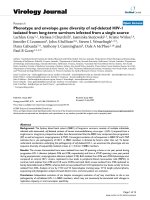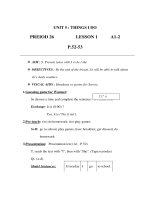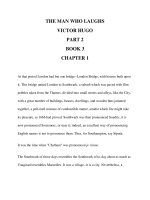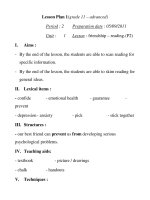PRESENTATION VOWELS CONSONANTS (1. Monothongs (Short long vowels) 2. Diphthongs 3. Triphthongs )
Bạn đang xem bản rút gọn của tài liệu. Xem và tải ngay bản đầy đủ của tài liệu tại đây (2.28 MB, 66 trang )
upper teeth
upper teeth
nose
nose
upper lip
upper lip
lower lip
lower lip
lower teeth
lower teeth
alveolar ridge
alveolar ridge
hard
palate
hard
palate
tounge
tounge
soft palate (velum)
soft palate (velum)
pharynx
pharynx
larynx
larynx
The main organs of Speech
vocal cords
vocal cords
Sounds can be divided into two main
types:
- A vowel is a sound that needs an open air
passage in the mouth. The air passage can be
modified in terms of shape with different mouth
and tongue shapes producing different vowels.
- A consonant is formed when the air stream is
restricted or stopped at some poins between
the vocal cords and the lips
Example: “sit”- the central sound in the word
“sit” is a vowel. The first and the third sound
are consonants.
VOWELS AND CONSONANTS
I. VOWELS
Vowels are divided into three types:
1. Monothongs (Short & long vowels)
2. Diphthongs
-
3. Triphthongs
1. Monothongs: Short vowels:
The symbol of short vowels are:
/ i e æ Λ D υ ∂ /
They can be described as follows:
Front Centre Back
Close
Close - mid
Open - mid
Open
/I/
/I/ is a half-close, short,
front vowel made with
spread lips.
Example words:
sit fish bit city
Front Centre Back
Close
Close - mid
Open - mid
Open
/e/
/e/ is a short, front vowel
produced with spread lips
Example words:
egg bet men get
/e/ does not occur in word-final position in English
Front Centre Back
Close
Close - mid
Open - mid
Open
/æ/
/æ / is a short, front open
vowel. It is made with the
lips in a neutrally open
position
Example words:
man add fat thank
Front Centre Back
Close
Close - mid
Open - mid
Open
/ Λ /
/ Λ / is a short, open,
centralised vowel.
Example words:
up son but funny
/Λ/ does not occur in word-final position
Front Centre Back
Close
Close - mid
Open - mid
Open
/D/
/D/ is a short, open back
vowel made in British
English with slightly
rounded lips and in the US
with neutrally open lips
Example words:
on pod cross gone
/D/ does not occur in word-final position
Front Centre Back
Close
Close - mid
Open - mid
Open
/υ/
/ υ / is a short, half-close,
back vowel pronounced
with lip-rounding
Example words:
put good pull could
/υ/ does not occur in word-initial position
Front Centre Back
Close
Close - mid
Open - mid
Open
/∂/
/∂/ is a short, central vowel
which occurs in the
unstressed syllables.
Example words:
ago mother banana
/∂/ is the only vowel sound in English with a name. /∂/ is
called ‘schwa”. All unstressed English vowels tend to be
realised as /∂/ .
2. Long vowels, diphthongs and
triphthongs:
2.1. Long vowels:
The symbol of long vowels are:
/ i: 3: a: u: /
They can be described as follows:
:c
:c
Front Centre Back
Close
Close - mid
Open - mid
Open
i:
/i:/ is a close, long, front
vowel made with spread
lips
Example words:
eat see free read
Front Centre Back
Close
Close - mid
Open - mid
Open
/3:/
/3:/ is a long, central vowel.
Example words:
bird sir girl term
/3:/ does not occur in US English.
Front Centre Back
Close
Close - mid
Open - mid
Open
/a:/
/a:/ is a long, open, back
vowel made with slightly
rounded lips
Example words:
art far calm card
/a:/ does not occur in US English.
Front Centre Back
Close
Close - mid
Open - mid
Open
is a long, half-open,
back vowel pronounced
with lip-rounding
Example words:
board all horse
/
/
:c/
:c/
/
/
:c/
:c/
Front Centre Back
Close
Close - mid
Open - mid
Open
/u:/ is a long, close, back
vowel produced with lip-
rounding
Example words:
too food soon
/u:/
2.2. Diphthongs
The total number of diphthongs is eight.
They are divided into three groups as this diagram:
Diphthongs
centring
ending in /∂/
/I∂/
/e∂/
/υ∂/
closing
ending in /I/
ending in /υ/
/ei/ /ai/
c
c
i/ /
/oυ/
/aυ/
The centring diphthongs glide towards
the /∂/ (schwa) vowel as the symbols
indicate:
Centring diphthongs
/I∂/: The starting point is
a little closer than /I/ in
“bit”, “bin”
Example words:
beard ear beer
/I∂/
Centring diphthongs
/e∂/: This diphthong begins
with the same vowel sound
as the /e/ of “get”, “men”
Example words:
air hair there
/e∂/
Centring diphthongs
/υ∂/: This has a starting
point slightly closer than /υ/
in “put”, “pull”
Example words:
tour sure moor
/υ∂/









